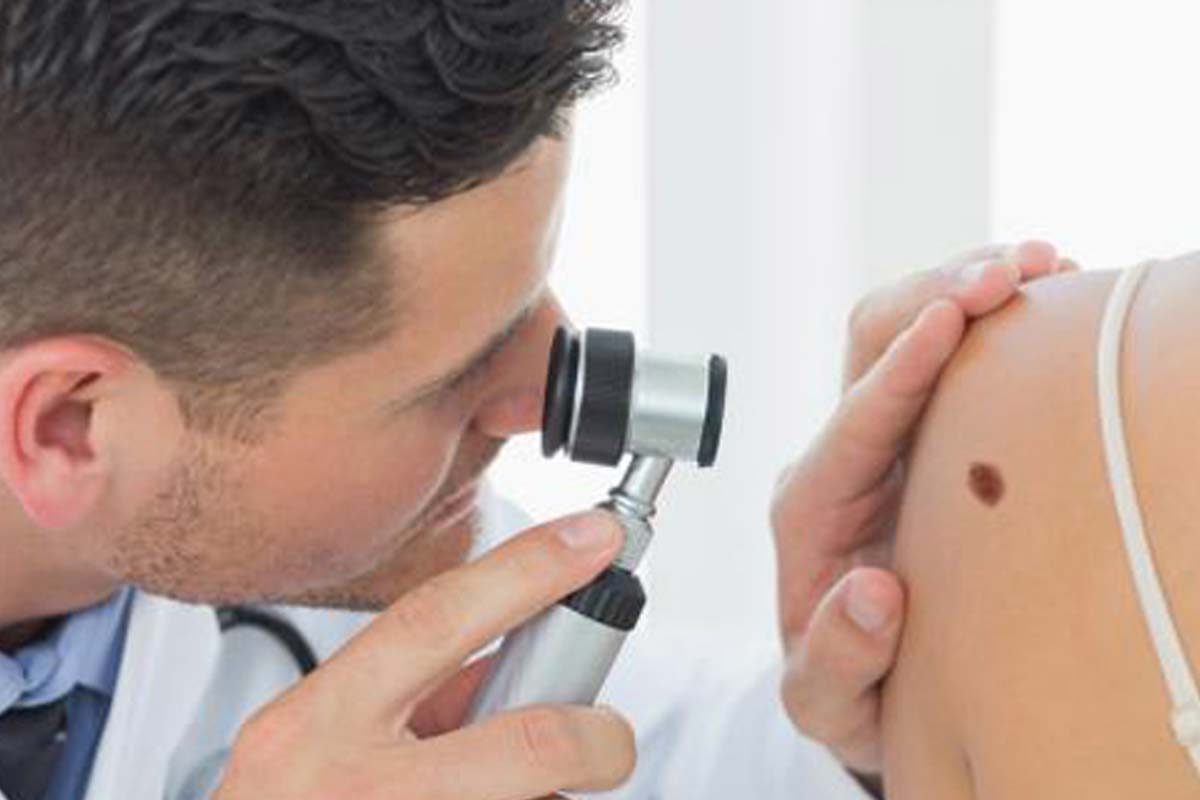
Dermatology
Melanoma is also known as malignant neoplasm, it is a type of cancer that develops from the pigment-containing cells known as melanocytes. It can be found predominantly on the skin, hence, it can arise on healthy skin or on a pre-existing mole. Melanoma rarely strikes on extra cutaneous areas where melanocytes are present (intestine, conjunctiva, leptomeninges). It presents an elevated biologic aggressiveness, and if not diagnosed quickly enough, tends to spread in the underlying dermis and to metastasize from a distance.
EPIDEMIOLOGY
The cutaneous melanoma (CM) represents 2-3% of all malignant tumours in the North of Europe and in the United States. In the last 20 years it has been estimated worldwide circa 100.000 new case of CM, with an increment of about 15% with respect to the last decade. In the year 2000, in Europe, 26.100 new cases of melanoma regarding males and 33.300 in females have been diagnosed. In Italy, the incidence of melanoma is of 7-10 cases/100.000 inhabitants/year. Women present a better prognosis. The higher incidence is between 30 and 50 years of age whereas it is rare it occurs to people younger than 15 years of age.
SIGNS ANS SYMPTOMS
Risk factors:
Skin phototype.Subjects who are hit the most are those with skin type I and II according to Fitzpatrick (bright eyes, red or blonde hair, light skin) who never get tanned.
Number of nevus and the presence of gigantic or atypical moles.The risk of melanoma is higher in the subject that possesses an elevated number of common or atypical melanocytic nevus. It is statistically demonstrated that the major occurrence of CM, is in subjects that present congenital gigantic nevi (more than 20 cm of diameter and/or which involve more than 1/5 of the skin surface). The CM occurs more frequently in the first 10 years of life.
Familial melanoma.About 10% of subjects affected from CM report at least another case in the family; in fact, it exists a genetic susceptibility in common with other neoplasms. In 10-12% of cases of familial melanoma, it has been found the mutation of the onco-supressor gene CDKN2A, localized on the chromosome 9p21 and which codifies for the protein p16.
Melanoma development.In 5% of the cases, it can be observed the appearance of a second melanoma (multiple melanoma).
Exogenous factors.
Sun exposure as a risk factor for the CM is to this day controversial. Epidemiologic and experimental studies have shown a significant correlation between CM’s occurrence, sun burns especially during childhood and the intense and intermittent exposures to the sun. It is not yet clear the role of UV rays originating from artificial sources on the occurrence of CM.
VERIFICATION
Specialist examination and Dermoscopy.
Cutaneous carcinomas are formed due to the neoplastic transformation of epidermal keratinocytes, the pilosebaceous and sweating adnexa, and the skin-mucous transit areas. The basal cell Carcinoma and squamous cell Carcinoma essentially represent skin carcinomas..
EPIDEMIOLOGY
Cutaneous carcinomas represent the most frequent neoplasm in subjects of Caucasian race. The incidence of cutaneous carcinomas is 18-20 times higher compared to the melanoma one; it is constantly increasing and varies depending on different factors, for example: race, the genetic predisposition, the age, gender, type of work and the geographical area. Cutaneous carcinomas constitute more than one third of all neoplasms in the U.S.A. with an estimated incidence above 600.000 cases per year. 90% of all cutaneous carcinomas is represented from basal cell carcinomas and 10% from squamous cell carcinomas. An even higher incidence of cutaneous carcinomas was registered in Australia with circa 1000-2000 per 100.000 cases per year. (1-4) The aetiopathogenesis of cutaneous carcinomas is correlated to exogenous and endogenous risk factors. The major exogenous risk factors are represented from: ultraviolet radiations (UV-A and UV-B), ionised radiations, prolonged exposure to chemical agents and to viral infections of Papilloma human virus (HPV). The prolonged exposure to UV rays has increased over the last years, both for business purposes and for the increase of recreational activities in open spaces, also for modifications of the ecosystem and for the fact that nowadays we live longer. The wavelength of UV rays with the greatest carcinogenic effect is between 200 and 400nm, in other words between UV-A and UV-B. Furthermore, the extended exposition to ionized radiations can determine the presence of cutaneous carcinoma after a latent period of 20-30 years in the treated areas. Between the exogenous risk factors, the prolonged exposition to certain chemical agents, such as arsenic salts and organic hydrocarbons, is thought responsible for the increase in multiple basal cell carcinomas; whereas the viral infection from HPV (HPV 16 and 18) determines an increase in the risk of incidence of squamous cell carcinomas in mucous and semimucous locations (anogenital, oral) especially in immunosuppressed subjects (8-9). Endogenous risk factors include the phototype, the genetic susceptibility, the iatrogenic immunosuppression, ulcers, burns, cutaneous chronic diseases and the sebaceous nevus. The phototype has been defined from Fitzpatrick according to the skin type of each individual of whichever human population. The classification of different phototype is based on the evaluation of the skin reactivity after photo exposure and it includes six different types of skin: the first four belong to Caucasian individuals while the fifth to the mixed-race, and the sixth to Negros. The more the subject is photo sensible (subject with light skin, with a lot of freckles and scarce or no ability to get tanned) the more the subject is at risk. The effect of UV rays will therefore be higher on a skin that is phenotypically prone to.
The pre-cancerous skin lesions are characterized by the presence of atypical epidermal cells that could lead to neoplastic degeneration if not treated correctly. The pre-cancerous skin can occur more frequently in subjects who are genetically (xeroderma pigmentosum, Gorlin syndrome, Basex syndrome, Muir-Yorre syndrome and epidermodysplasia verruciformis) or phenotypically prone to. The most frequent pre-cancerous conditions are the actinic keratosis, cutaneous horn, actinic cheilitis and the leukoplakia.
BASAL CELL CARCINOMA
The basal cell carcinoma (BCC) derives from the proliferation of multi-potent keratinocytes, which are incompletely differentiated. These keratinocytes are similar to the basal layer of the epidermis. BCC can appear on an apparently healthy skin, it has a slow growth and it is locally invasive and rarely metastasizing. It is rare under 40 years of age and is more frequent in males. The most frequent locations are the face, especially on the central region (the nose represents 25-30% of all areas), the neck and the trunk. The neoplasm can be unique, however it is often multiple.
Different types. Different kind of basal cell carcinomas exist: nodular, superficial, sclerodermiform and pigmented.
.
Nodular basal cell carcinoma
It comes as a papule or a translucent nodule of a hard-elastic consistency with a smooth surface occasionally wrecked with thin telangiectasias. In the most advanced phases of illness, a central ulceration can appear with a crateriform morphology that can be covered by a crusty formation.
Superficial basal cell carcinoma
It is found more commonly in adults especially on the trunk. It appears clinically as a single or as many multiple spots, plane or slightly atrophic, ovular or roundly shaped, delimited by a thin pearled border.
Sclerodermiform basal cell carcinoma
It appears as a white-yellowish plaque with unclear margins therefore hard to identify during the surgical removal. It has a hardly recognizable form and rapidly infiltrates the tissues underneath.
Pigmented basal cell carcinoma
The melanin pigments can be present in tracks or can occupy the entire lesion making the diagnosis of the melanoma hard. Typical characteristics are represented by the translucent appearance, the slow evolution and the pearled border.
SQUAMOUS CELL CARCINOMA
Squamous cell carcinoma (SCC) is a malignant neoplasm formed by keratinocytes that mimic the cells of the malpighian layer of the epidermis. Skin and mucous membranes can be involved. The locations that are majorly interested are the head and the neck (50-60% of the cases). The neoplasm may arise de novo, or on a pancreatic condition such as the actinic keratosis, or on a carcinoma in situ (Bowen’s disease). The SCC is an aggressive neoplasm with an infiltrating capacity able to metastasize both through lymphatic way and through hematic way.
Different types. Different clinical variants exist: nodular-ulcerative form, vegetative form, superficial form, warty form.
Nodular-ulcerative form
It is the most frequent and appears as a nodule with a central ulceration, at times covered with a hyperkeratotic scale or crust.
Vegetative form
It is characterised by an appearance that is predominantly proliferative and not ulcerated. Clinically, it presents itself as a bulky fleshy mass.
Superficial form
Is rare and is characterized by a little infiltrated spot, with or without ulceration.
Warty form
It is an anatomical and clinical variant of squamous cell carcinoma with a low degree of malignity, with aggressiveness predominantly local. It is localized most frequently in the oral, nasal, laryngeal or genital mucous membranes, and under the sole of the feet. These clinical forms may be secondary to chronic inflammations, chemical carcinogenic and infection by papilloma virus.
Queste forme cliniche possono essere secondarie a infiammazioni croniche (lichen sclero-atrofico), cancerogeni chimici e infezione da papilloma virus.
VERIFICATION
Specialist examination and Dermoscopy.

